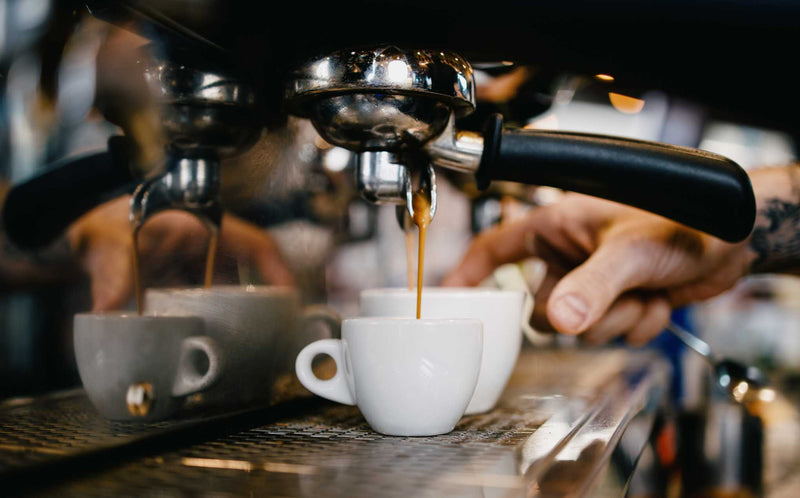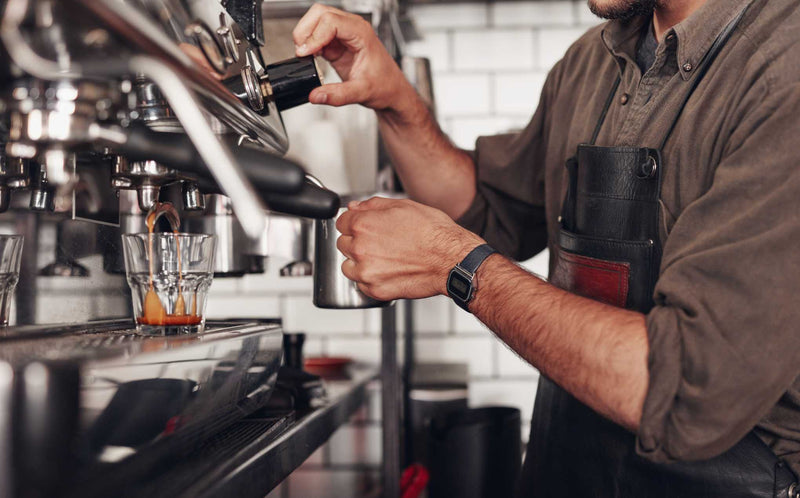Coffee at the bar vs coffee at home: how habits have changed
Coffee , more than a simple drink, is a ritual, a symbol of conviviality and a driver of tradition and innovation throughout Italy and beyond its borders in Europe . This article explores the evolution of habits related to coffee consumption , comparing the historic tradition of coffee at the bar with the growing trend of enjoying it at home , revealing how habits have transformed over time and what factors have influenced these changes .

Brief history of coffee consumption
In Italy , since the 17th century, when the first cafés opened in Venice , coffee has become an important element in the culture, rapidly expanding throughout the country. Drinking a coffee is an activity that varies from region to region and from country to country and represents a reflection of the various cultures and consumer preferences.
Despite the difference in usage habits from one area to another, coffee proves to be a versatile product capable of adapting to different tastes and traditions. Just think of countries like France where coffee is enjoyed in outdoor cafés or Scandinavia where drinking coffee is mainly served filtered.
The evolution of coffee consumption habits
In recent years we have seen a significant change in coffee consumption habits , accelerated by restrictions related to the COVID-19 pandemic. These dynamics have pushed many coffee lovers to recreate the bar experience at home , using advanced coffee machines and becoming increasingly aware of purchasing high quality coffee. At the same time, coffee at the bar continues to play a central role in Italian and European social life, but its consumption is adapting to new consumer needs with different and innovative offers.
But how have habits related to coffee at home and in bars changed in Italy and Europe?
Coffee in Italy
Coffee culture and tradition
The tradition of Italian coffee , as we have seen many times, is characterized by espresso . But the coffee experience, which has always been seen as a break and a moment of conviviality, is slowly transforming. Consumers are becoming increasingly informed and aware of the varieties, origins and preparation methods of coffee . This growing awareness is leading to a significant change in coffee culture: espresso is no longer relegated to the quick drink standing at the bar counter, a typical one-minute experience. On the contrary, the trend is spreading to enjoy the drink in places that offer the possibility not only of staying longer, but also of working or carrying out other activities in a welcoming and stimulating environment.
Drinking coffee at the bar

The average Italian, however, continues to start his day with a coffee at the bar , a ritual that is repeated even after lunch or during the day . The espresso at the counter, consumed quickly, remains the predominant choice, followed by variants such as the cappuccino, preferred in the morning breakfast, and the caffè macchiato. According to ISTAT , before the pandemic , over 70% of Italians went to bars at least once a week for a coffee . However, this number has seen a decline in recent years due to various factors, including the increasing quality of home-brewed coffee.
Coffee consumption at home

The trend of consuming quality coffee at home has seen exponential growth , especially in the context of the pandemic . Sales of home coffee machines and capsules have seen a significant increase, a sign of a change in consumer habits.
While espresso continues to be the preferred choice, there is a growing interest in higher quality coffee and alternative preparation methods , such as filter coffee or French press.
In other words, the art of preparing coffee at home is being rediscovered, but as seen previously, the bar remains a pillar of Italian culture, an irreplaceable meeting place despite fluctuations in consumption habits.
And how is coffee consumption changing in Europe?
Coffee in Europe
Overview of coffee consumption
Coffee consumption varies significantly in Europe depending on the reference area. Nordic countries, such as Finland and Sweden, lead the statistics with the highest per capita coffee consumption in the world, favoring filtered coffee . In southern Europe , including Italy, espresso and its variants dominate , while in the UK and Ireland, tea has traditionally taken precedence, although coffee is gaining ground.
Coffee consumption at bars in Europe

Coffee consumption at home in Europe

Interest in domestic coffee machines is growing across Europe , with particular interest in espresso machines in countries where previously mainly filtered coffee was consumed.
The variety of coffee cultures in Europe reflects the richness and diversity of the continent itself. However, a common trend clearly emerges: a growing interest in high-quality coffee and an increased interest in home brewing . These changes are influenced by various factors, in particular on the one hand the availability of more technologically advanced machines and extraction methods for coffee extraction, on the other hand a greater awareness on the part of consumers regarding the origins and quality of coffee.
New trends in coffee consumption are changing not only habits but also the environment and the economy. There is a push towards quality and sustainability, which leads the world of coffee to become more attentive to the environment and social responsibility. These changes are influencing how coffee is produced and consumed, with an eye on the planet.
Towards more sustainable coffee consumption
The growing interest in coffee, both as an experience and as a product, presents a series of economic and environmental challenges and opportunities. As the industry adapts to changing consumer habits, the importance of more sustainable approaches to coffee consumption is clear. Encouraging conscious consumption practices, supporting innovation in the sector and promoting sustainability throughout the production and distribution chain are essential steps to ensure that coffee can continue to be a valuable part of our lives, without compromising the well-being of the planet.
In this dynamic scenario, it is essential for a company like Cellini Caffè to be at the forefront, anticipating and responding to changes in coffee consumption habits. This commitment translates into the continuous development of new solutions to meet customer needs, offering a wide range of superior quality coffees for both home and bar consumption.


